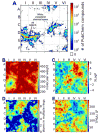Stochastic voyages into uncharted chemical space produce a representative library of all possible drug-like compounds
- PMID: 23548177
- PMCID: PMC3670418
- DOI: 10.1021/ja401184g
Stochastic voyages into uncharted chemical space produce a representative library of all possible drug-like compounds
Abstract
The "small molecule universe" (SMU), the set of all synthetically feasible organic molecules of 500 Da molecular weight or less, is estimated to contain over 10(60) structures, making exhaustive searches for structures of interest impractical. Here, we describe the construction of a "representative universal library" spanning the SMU that samples the full extent of feasible small molecule chemistries. This library was generated using the newly developed Algorithm for Chemical Space Exploration with Stochastic Search (ACSESS). ACSESS makes two important contributions to chemical space exploration: it allows the systematic search of the unexplored regions of the small molecule universe, and it facilitates the mining of chemical libraries that do not yet exist, providing a near-infinite source of diverse novel compounds.
Figures




References
-
- Beyond the Molecular Frontier: Challenges for Chemistry and Chemical Engineering. The National Academies Press; Washington, D.C: 2003. - PubMed
-
- Sauer WHB, Schwarz MK. J Chem Inf Comp Sci. 2003;43:987. - PubMed
-
- Schreiber SL. Nature. 2009;457:153. - PubMed
-
- Dandapani S, Marcaurelle LA. Nature Chem Bio. 2010;6:861. - PubMed
-
- Bohacek RS, McMartin C, Guida WC. Med Res Rev. 1996;16:3. - PubMed
Publication types
MeSH terms
Substances
Grants and funding
LinkOut - more resources
Full Text Sources
Other Literature Sources

